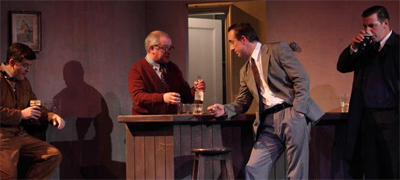Tom Murphy’s The House is big play with some clever ideas, but not quite enough to fill its somewhat extended run time. In fact, the first half of the play, as Murphy tries to settle into his groove, seems to run nearly forever – to the point where, sitting in my seat, I was starting to wonder if the actors had simply forgotten there was supposed to be an intermission. The second half, however, is much stronger and much more tightly focused. While the production itself is nothing less than impressive, one wonders if an editor might have been well-suited to take a hacksaw to Murphy’s script, or perhaps director Annabelle Comyn might have cut down on the staring into middle-distance.
The House is, of course, highly relevant to modern Ireland. Set during the emigration crisis of the fifties, there are obvious parallels to the present day. Those earlier young men, it seems, had the common courtesy to wait until they came home before acting like a bunch of anti-social drunken louts, instead of doing it abroad, as they currently seem to be doing in Australia. Not one of our returning emigrants ends the play without some brush with the law, whether for drunk and disorderly conduct, property damage, or worse. There’s a sense of mourning as the nation watches its best and brightest migrating in search of work, while those same young bodies end up lost and adrift without a place to call home.
In fairness, Murphy’s depiction of country life seems to ring true. I’ve heard stories of those who remained behind being shocked at the antics of their returning brethren, suddenly rich from jobs in England or America. It’s strange, after so much time in Dublin, to hear words and phrases like “buff-sham” used to label various individuals, and the portrayal of the local innkeeper rings quite true for many small Irish towns up until recently. It seems like Bunty controls the whole town, whether the dance hall, the local tavern or even the cinema, creating the impression of a very small world.
That said, there’s no denying that Murphy’s scripting is a little indulgent at times. There seem to be far too many scenes, and many go on far longer than is necessary. Murphy spends the bones of the first act establishing atmosphere almost meticulously. That’s not an inherently bad thing, but it feels like things only really start happening in the second act, as the sale of the eponymous piece of property grows gradually closer. Some restraint might have been admirable in the script, which doesn’t hesitate to spell out and repeat a host of observations that were originally insightful, but wind up becoming very irritating.
As a result, the play feels quite unwieldy for what it actually is. It is the story of a returning Irish immigrant who wants to do right by his surrogate family and perhaps to put down roots in his country. Sure, there’s a whole host of themes playing themselves out, but there’s a point where extending the play to two-and-a-half hours seems a little self-indulgent. Brevity is the soul of wit, but it’s not the enemy of the playwright either. Director Annabelle Comyn only increases this problem by insisting on allowing Murphy’s script room to breath. So there are long, awkward, pregnant pauses, a lot of staring forlornly, and far too much silence – it seems as if the play is more concerned with convincing us that it is profound, rather than actually being profound.
Still, there’s a lot like here. The lighting and set design are absolutely fantastic. The lightly makes the stage seem like it’s almost faded and worn, creating the impression of a time long ago. Chahine Yavroyan’s design is always pitch perfect, capturing the sense of twilight or the mid-summer sun, casting everything in a nebulous old-fashioned past, a time that is long gone and yet strangely tangible.
Paul O’Mahony’s set design is as rich and beautiful as it is complex, with a series of rotating locales spinning into and out of shot, creating an impression of an eternal loop – perhaps illustrating how country life must seem to some of those trapped in it. Pub, home, fields, pub, home, fields.Just a finite set of combinations. It works remarkably well, with each turn of the set reconfiguring to create a backdrop. It’s very intricate and stylish, and arguably the most fascinating piece of the play.
The cast do a decent job with the material, occasionally trying to inject a bit of life into a play that feels a little too long and indulgent to hold the attention. While the entire supporting cast is solid, Declan Conlon is superb in the leading role of Christie. What exactly Christie does overseas to earn so much money is hinted at throughout the play, and the suggestion is made that Christie has returned home with some sins he’d hope to escape. Conlon gives the character a charm and wit that makes him compelling and engaging lead, doing is best to hold everything together. It’s a great leading performance, arguably far stronger than the material.
The House has all the ingredients to be a great play. Unfortunately, it doesn’t seem to have the self-restraint necessary to mix them into something truly memorable, instead opting to try to fit in too much of anything, reluctant to trim any excess material to produce a tighter and more streamlined piece of theatre.
Filed under: Theatre | Tagged: abbey theatre, Alison Croggon, arts, Australia, Bunty, Canberra, Downton Abbey, dublin, england, house, Ireland, Irish American, Irish diaspora, London, Murphy, Performing Arts, Public Broadcasting Service, Theatre, United States |
























Reblogged this on Romeo Sank.
Cheers!